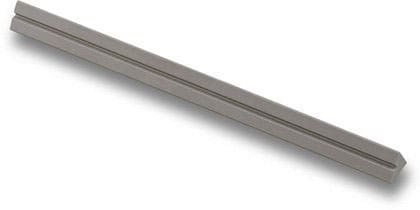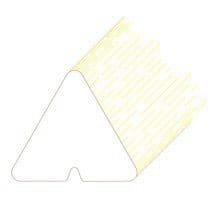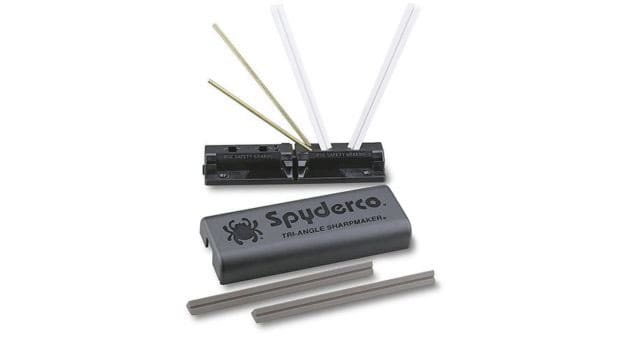We’ve got the last knife and tool sharpener you’ll ever need: the Spyderco Tri-Angle Sharpmaker®.
Don’t worry, this isn’t another one of those cheesy “WARNING!” articles about the necessity of a sharp knife, and therefore a good sharpener. By now you, and every red-blooded knife owner in the universe, should know that to be true.
But since you put so much time into choosing the right knife, you’ve got to at least consider a few things when choosing a sharpener, right? That’s true as well, and not every sharpener is as top-of-the-line as the makers would have you think.
Spyderco and their team of knife experts know that the key to sharpening any cutting tool is removing the steel at the edge, while still maintaining a consistent angle between the blade and the stone. This is tricky to do, especially if you don’t do it often enough.
The Tri-Angle Sharpmaker makes this process almost turnkey, and enables anyone to sharpen a knife with just a few minutes of practice.
Not everybody knows this, but the Tri-Angle Sharpmaker was actually the first product that Spyderco ever made, before the brand ever made a knife, they made the Tri-Angle Sharpmaker. They even have a trademarked line, “First we made things sharp, then we made sharp things.™”
The plastic base on the the Tri-Angle Sharpmaker is nice and durable, and the precisely keyed holes accurately set the stones’ sharpening angles at 30° (15° each side) or 40° (20° each side) for sharpening knives. It’s pretty simple: You just keep the plane of your knife’s blade vertical and draw the edge along each stone to sharpen.
For serrated blades, knife owners can use the rounded edges of the stones and a slightly looser grip. This allows the stone to flow into the recesses of each serration.


The Sharpmaker system includes two sets of high alumina ceramic stones: medium-grit (brown) for aggressive sharpening, and a set of fine (white) stones for professional-grade finishing. Two brass safety rods protect your hands, plus each and every one of the components snaps into the self-contained base and lid, meaning you can store it away without a bag or box. You won’t have any nervousness about losing a piece.
Every Sharpmaker comes complete with instructions, so you’ll know the process of sharpening knives, scissors, awls, and many other tools in no time.

Knife owners who are worth their weight would never want a knife they couldn’t reliably sharpen, and more often than not they resort to the experts. Now those experts can be replaced with an in-home tool, small and inconspicuous but super effective at the same time. Plus, it will pay for itself sooner than later, especially if you’ve become used to the fees a pro would charge to sharpen a few kitchen or outdoor knives.
Take a look once more at this simple design, and ask yourself: Isn’t it time I got a trustworthy knife sharpener?





I’ve had one for decades. Love it.
I’ll second that! I bought it around 2005 at The Spyderco store in Golden. To this day, it’s one of those few purchases I’ve never regretted!
This is a fantastic and very versatile product. If you have anything with a blade – from scissors to your EDC knives – that needs to be refreshed, this kit can help you do that very efficiently.
This is a fine product. I suggest shopping around for the best price; the variation is pretty large.
Have used one to polish trigger components. Ownership of this and a Leatherman PST is a sure sign of good people.
Get a TSPROF sharpening system, and call it a day. Leave this piece of chit in the dumpster with with Lansky and (shudder) Chef’s Choice crap.
And the price is so comparable, and it sharpens serrated edges so wellllllllll.
If you can’t figure out how to sharpen a serrated edge with the TSPROF system, then you should probably stay away from anything sharp and pointy in the first place. And yes, it costs money. If you’re on welfare/unemployment or something and can’t/won’t work then don’t get it, buy a flat sharpening stone form walmart for $5. That’ll get the job done.
The best sharpener I have used for 15 years is an 8″ paper wheel on a buffing motor. Search around for paper wheel knife and tool sharpeners.
The kit comes with two wheels, one for sharpening and one for grinding. The grinding paper wheel has grit embedded with yellow glue and extra grit is included. This grinding wheel will not overheat and blue what you are grinding
Sharpening a dull knife usually doesn’t take even a minute, depending upon the steel hardness. Draw the edge over the wheel and it will polish to a mirror finish without installing a burr. The sharpening wheel uses buffing compound.
I sharpen knives, chisels, axes, anything that needs an edge seemingly 100 times faster than I used to!
Use all your other sharpeners and then run the blade over the paper wheel and you will find out what sharp is.
All my diamond plates and wet stones sit in a drawer gathering dust until I need them to reestablish cutting angles, maybe every 2 or 3 years.
dmt hones. once you have an edge…
For all you folks out there who can actually put a good edge on a blade, please consider doing a write-up for TTAG (and TTAK) and educate us edge heathens on how to do the job right.
And like always, another nice hunt Tom is kind enough to let us tag along with.
I hear ya on the cold, Thomas.
My first Boy Scout overnight was in winter. The next morning, I awoke to find my boots I put neatly outside the night before filled with snow…
You guys sure that having “sponsored content” under “editorials” is a good idea?
Comments are closed.